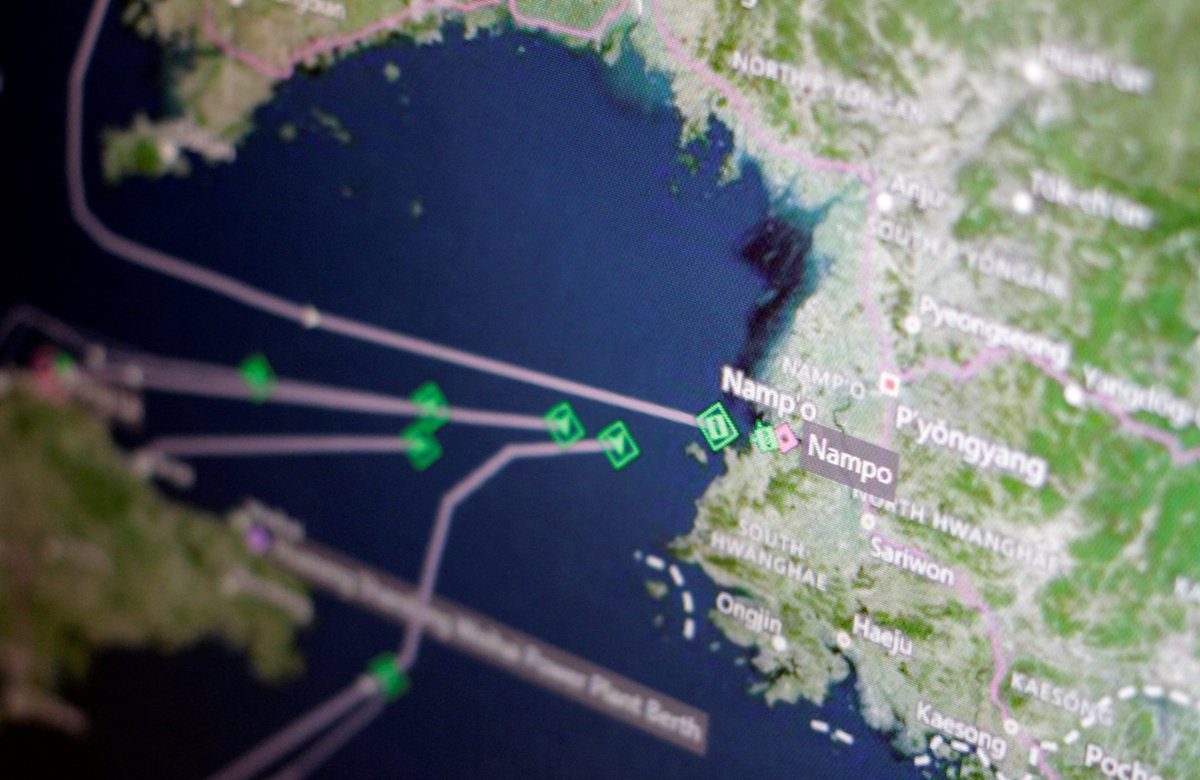A Thomson Reuters Eikon ship-tracking screen shows cargo ships returning to Nampo port in North Korea April 11, 2017. REUTERS/Thomas White/Illustration
 By Meng Meng and John Ruwitch
By Meng Meng and John Ruwitch
SHANGHAI, April 11 (Reuters) – A fleet of North Korean cargo ships is heading home to the port of Nampo, the majority of it fully laden, after China ordered its trading companies to return coal from the isolated country, shipping data shows.
Following repeated missile tests that drew international criticism, China banned all imports of North Korean coal on Feb. 26, cutting off the country’s most important export product.
To curb coal traffic between the two countries, China’s customs department issued an official order on April 7 telling trading companies to return their North Korean coal cargoes, said three trading sources with direct knowledge of the order.
U.S. President Donald Trump and Chinese President Xi Jinping were discussing North Korea at Trump’s Mar-a-Lago resort on April 7.
Shipping data on Thomson Reuters Eikon, a financial information and analytics platform, shows a dozen cargo ships on their way to North Korea’s main west coast port of Nampo, almost all carrying cargoes from China.
Chinese authorities did not respond to requests for official comment.
The Trump administration has been pressuring China to do more to rein in North Korea, which sends the vast majority of its exports to its giant neighbor across the Yellow Sea.
But U.S. Secretary of State Rex Tillerson has said last week’s U.S. military strike against Syria over its alleged use of chemical weapons was a warning to other countries, including North Korea, that “a response is likely” if they pose a danger.
As a U.S. Navy strike group headed to the region in a show of force, China and South Korea agreed on Monday to slap tougher sanctions on North Korea if it carries out nuclear or long-range missile tests, a senior official in Seoul said.
North Korea marks several major anniversaries this month and often marks the occasions with major tests of military hardware.
TWO MILLION TONNES
A source at Dandong Chengtai, one of China’s biggest buyers of North Korean coal, said the company had 600,000 tonnes of North Korean coal sitting at various ports, and a total of 2 million tonnes was stranded at Chinese ports.
Eikon data shows that most of these ships have recently left Chinese coal ports, including Weihai and Peng Lai, returning to North Korea full or mostly filled with cargo.
Last month, Reuters reported that Malaysia briefly prevented a North Korean ship carrying coal from China from entering its port in Penang because of a suspected breach in sanctions. The ship was eventually allowed to unload its 6,300 metric tonnes of anthracite coal. North Korea is a significant supplier of coal to China, especially of the type used for steel making, known as coking coal.
To make up for the shortfall from North Korea, China has ramped up imports from the United States in an unexpected boon for U.S. President Donald Trump, who has declared he wants to revive his country’s struggling coal sector.
Eikon data shows no U.S. coking coal was exported to China between late 2014 and 2016, but shipments soared to over 400,000 tonnes by late February .
This trend was exacerbated after cyclone Debbie knocked out supplies from the world’s top coking coal region in Australia’s state of Queensland, forcing Chinese steel makers to buy even more U.S. cargoes.
The other big coking coal supplier that has ramped up exports to China since the ban on North Korean cargoes is Russia. .
(Writing by Henning Gloystein; Editing by Bill Tarrant)
(c) Copyright Thomson Reuters 2017.

 Join The Club
Join The Club











